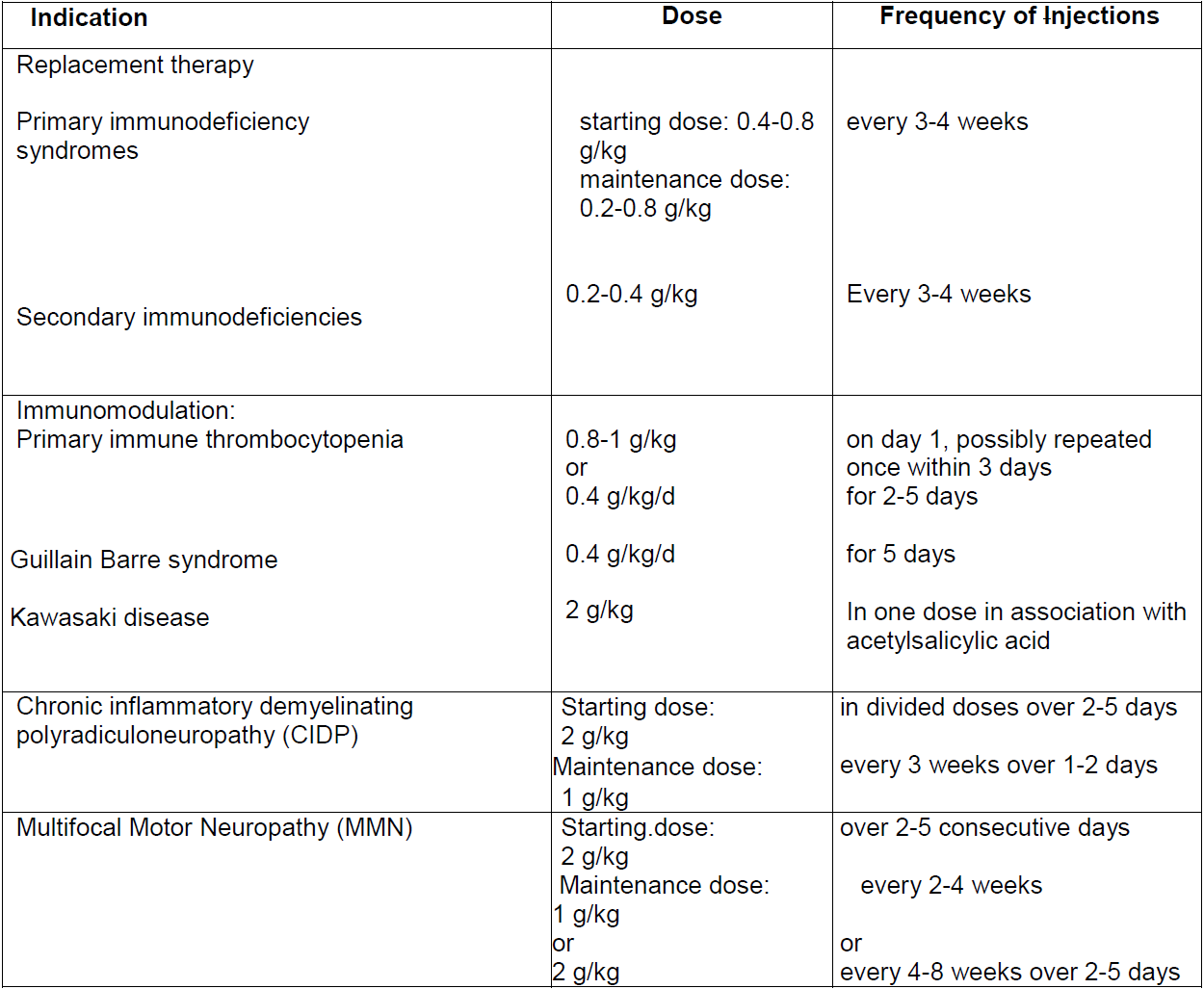Regulatory Information
HSA regulatory responsibility and product classification details
Regulatory Responsibility
Product Classification
Formulation Information
INFUSION, SOLUTION
**Posology and Method of administration** Replacement therapy should be initiated and monitored under the supervision of a physician experienced in the treatment of immunodeficiency. Posology The dose and dose regimen is dependent on the indication. The dose may need to be individualized for each patient dependent on the clinical response. Dose based on bodyweight may require adjustment in underweight or overweight patients. The following dose regimens are given as a guideline _Replacement therapy in primary immunodeficiency syndromes:_ The dose regimen should achieve a trough level of IgG (measured before the next infusion) of at least 6 g/l or within the normal reference range for the population age. Three to six months are required after the initiation of therapy for equilibration (steady-state IgG levels) to occur. The recommended starting dose is 0.4 – 0.8 g/kg given once, followed by at least 0.2 g/kg given every three to four weeks. The dose required to achieve a trough level of IgG of 6 g/l is of the order of 0.2 – 0.8 g/kg/month. The dosage interval when steady state has been reached varies from 3 – 4 weeks. IgG trough levels should be measured and assessed in conjunction with the incidence of infection. To reduce the rate of bacterial infections, it may be necessary to increase the dosage and aim for higher trough levels. _Secondary immunodeficiencies:_ The recommended dose is 0.2–0.4 g/kg every three to four weeks. IgG trough levels should be measured and assessed in conjunction with the incidence of infection. Dose should be adjusted as necessary to achieve optimal protection against infections, an increase may be necessary in patients with persisting infection; a dose decrease can be considered when the patient remains infection free. _Primary immune thrombocytopenia_ There are two alternative treatment schedules: - 0.8–1 g/kg given on day one; this dose may be repeated once within 3 days - 0.4 g/kg given daily for two to five days The treatment can be repeated if relapse occurs. _Guillain Barre syndrome_ 0.4 g/kg/day over 5 days (possible repeat of dosing in case of relapse). _Kawasaki Disease_ 2.0 g/kg should be administered as a single dose. Patients should receive concomitant treatment with acetylsalicylic acid. _Chronic inflammatory demyelinating polyneuropathy (CIDP)_ Starting dose: 2 g/kg divided over 2–5 consecutive days. Maintenance doses: 1 g/kg over 1–2 consecutive days every 3 weeks. The treatment effect should be evaluated after each cycle; if no treatment effect is seen after 6 months, the treatment should be discontinued. If the treatment is effective long term treatment should be subject to the physicians discretion based upon the patient response and maintenance response. The dosing and intervals may have to be adapted according to the individual course of the disease. _Multifocal Motor Neuropathy (MMN)_ Starting dose: 2 g/kg given over 2–5 consecutive days. Maintenance dose: 1 g/kg every 2 to 4 weeks or 2 g/kg every 4 to 8 weeks. The treatment effect should be evaluated after each cycle; if no treatment effect is seen after 6 months, the treatment should be discontinued. If the treatment is effective long term treatment should be subject to the physicians discretion based upon the patient response and maintenance response. The dosing and intervals may have to be adapted according to the individual course of the disease. The dosage recommendations are summarised in the following table:  _Paediatric population_ The posology in children and adolescents (0–18 years) is not different to that of adults as the posology for each indication is given by body weight and adjusted to the clinical outcome of the above-mentioned conditions. _Hepatic impairment_ No evidence is available to require a dose adjustment. _Renal impairment_ No dose adjustment unless clinically warranted. _Elderly_ No dose adjustment unless clinically warranted. Method of administration Intravenous use. Intratect should be infused intravenously at an initial rate of not more than 0.3ml/kg/h for 30 minutes. In case of adverse reaction, either the rate of administration must be reduced or the infusion stopped. If well tolerated the rate of administration may gradually be increased to a maximum of 1.9 ml/kg/h. The solution should be clear or slightly opalescent and colourless or pale yellow. Solutions that are cloudy or have deposits should not be used. The product should be brought to room or body temperature before use.
INTRAVENOUS
Medical Information
**Indications** Replacement therapy in adults. and children and adolescents (0–18 years) in: - Primary immunodeficiency syndromes (PID) with impaired antibody production. - Secondary immunodeficiencies (SID) in patients who suffer from severe or recurrent infections, ineffective antimicrobial treatment and either **proven specific antibody failure (PSAF)\*** or serum IgG level of <4 g/l. \*PSAF= failure to mount at least a 2-fold rise in IgG antibody titre to pneumococcal polysaccharide and polypeptide antigen vaccines Immunomodulation in adults. children and adolescents (0–18 years) in: - Primary immune thrombocytopenia (ITP), in patients at high risk of bleeding or prior to surgery to correct the platelet count. - Guillain Barre syndrome. - Kawasaki disease (in conjunction with acetylsalicylic acid). - Chronic inflammatory demyelinating polyradiculoneuropathy (CIDP). - Multifocal motor neuropathy (MMN).
**Contra-indications** Hypersensitivity to the active substance (human immunoglobulins) or to any of the excipients. Patients with selective IgA deficiency who developed antibodies to IgA, as administering an IgA-containing product can result in anaphylaxis.
J06BA02
immunoglobulins, normal human, for intravascular adm.
Manufacturer Information
GRIFOLS ASIA PACIFIC PTE. LTD.
Biotest AG
Active Ingredients
Human normal immunoglobulin (human plasma protein containing at least 96% immunoglobulin)
50 mg/ml
Documents
Package Inserts
Intratect Solution for Infusion PI.pdf
Approved: November 26, 2020
